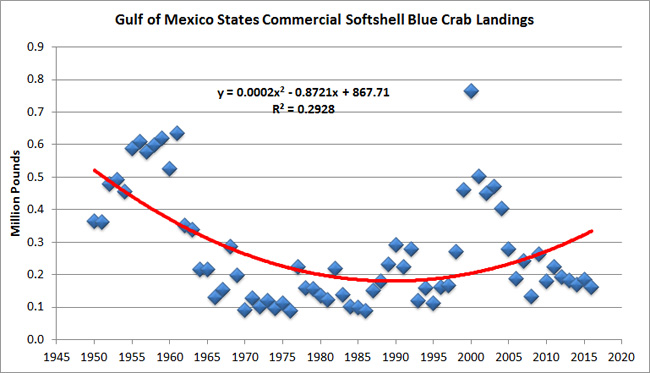ANALYSIS OF THE COSTS OF SOFTSHELL BLUE CRAB POND GROWOUT IN THE UNITED STATES
Benedict Posadas, Ph.D.
Mississippi State University, Coastal Research, and Extension Center
1815 Popps Ferry Road, Biloxi, MS 39532
Ben.Posadas@msstate.edu
Novermber 1, 2018
Working with crab scientists, specialists, and producers in Mississippi and North Carolina, Dr. Posadas started creating enterprise budgets for softshell blue crab pond grow-out systems in November 2018. Pond design, construction, and costs data are being collected to develop the initial investment required to establish a commercial softshell crab pond production enterprise. The experimental production operations are conducted in the two locations. Experimental ponds are being designed and constructed in North Carolina, while existing ponds in Mississippi are being prepared for the experimental production operations in spring 2019.
This is a three-year project externally-funded by the National Oceanic and Atmospheric Administration (NOAA), National Sea Grant Program. Dr. Posadas devotes 15 percent (6 hr/wk on Thursdays) of this time to perform the tasks outlined in the project proposal starting on November 1, 2018.

To view more of the Mississippi, Gulf of Mexico and United States commercial softshell blue crab landings, click this LINK.
The U.S commercial softshell blue crab landings had drastically declined since 2000. This decline in commercial softshell blue crab landings radically altered the domestic market situation for blue softshell crabs. The ex-vessel prices of blue softshell crab have been persistently increasing over the years, with a marked increase during the last five years after the recession and the Gulf of Mexico oil spill.
The overall objective of this economic analysis is to evaluate the costs of producing blue softshell crabs in the pond grow out production system. Specifically, it aims to achieve the following objectives:
1. To estimate the investment requirements and ownership costs of producing blue softshell crabs in pond grow out production system.
2. To evaluate the operating costs of producing blue softshell crabs in the pond grow out production system.
3. To develop optimal economic models of softshell blue crab production systems subject to supply and technological constraints.
The evaluation of the costs of pond grow out of blue softshell crab in the Southern United States will be based upon a hypothetical commercial pond production system (CPPS) using experimental results and commercial production practices in Mississippi and North Carolina. Operating costs will be estimated based on recommended management practices, biological knowledge of the species, estimated input usage and prices. A detailed description of the type, number, and costs of land, pond construction, machinery, and equipment necessary for the base CPPS model will be developed.
Dr. Posadas conducted economic analysis on various aquaculture species in the past in Southeast Asia and the United States, including but not limited to the following aquaculture production systems:
- He compared the economic feasibility of three pond production systems for Tiger prawns in the Philippines (Posadas, 1988a).
- In the Philippines, he monitored eight weekly inputs and outputs of seaweed farmers in three different locations. Using survey results, he assessed the industry costs and returns (Posadas, 1988b).
- He surveyed over a dozen softshell crawfish producers in Mississippi and evaluated the industry costs and returns of two shedding systems(Posadas and Homziak, 1991; 1993).
- He developed economic models based on experimental and industry performance for the production of freshwater prawns in ponds in temperate countries (D’Abramo et al., 2003).
- In East Mississippi, he surveyed 15 catfish farmers and developed budgets for non-Delta catfish pond production systems (Posadas, 2000).
- He visited experimental and commercial saltwater shrimp operations in Mississippi, South Carolina, and Hawaii and developed economic models for biosecure shrimp production systems (Posadas and Hanson, 2006).
- In the Gulf of Mexico, he assessed the economic feasibility of offshore production systems for red snapper, speckled trout, and cobia (Posadas and Bridger, 2003; 2004).
Similar economic modeling techniques will be adopted for softshell blue crab pond production systems in Mississippi and North Carolina. Different CPPS scenarios will be created to assess the impacts of changes in the biological and technical aspects of production. These publications are listed in http://coastal.msstate.edu/aquaculture-economics-publications.
